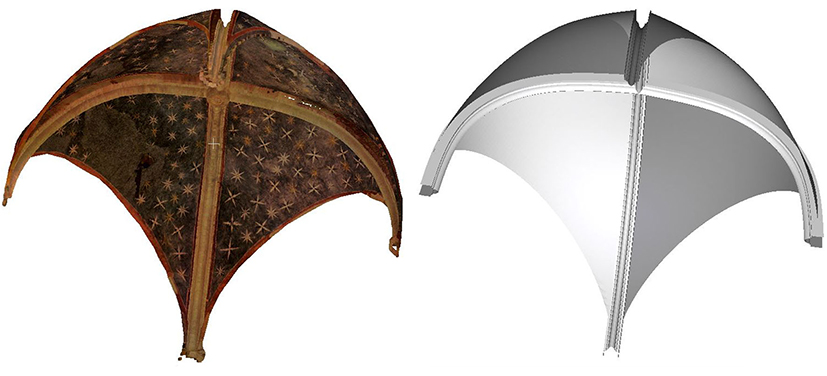
Architectural Heritage Imaging: When Graphical Science Meets Model Theory
Abstract
In the field of Architectural Heritage (AH), the Representative Model – that is an Interpretative Model by its very nature – is the core of the process of study, knowledge, understanding, communication, and valorisation (De Luca & Russo, 2021). The use of the interpretative model recalls the so-called Model Theory (Hodges, 2020), and in particular in the AH field the representative model acts in the visual dimension. This model is a cultural product, synthesis of the apparent oppositions between tangible and intangible, signifier and meaning, reality and interpretation, picture and image, history and memory.
AH current lines of study suggest combining Model Theory with Visual Sciences (Bertoline, 1998; Mitchell, 2015), and therefore with the Graphical Science (Cardone, 2017; Cicalò, 2020), favouring the broadening of the traditional fields of representation, drawing, geometry, and history. It fosters the understanding of the heuristic role of the architectural interpretative model: The process of drawing and modelling becomes a methodology of analysis, in the sense of a process of visual computing of spatial, historical, and cultural characteristics of built heritage; In this way the model is a sort of multi-dimensional vector that reproduces significant aspects of the architectural phenomena, and thus facilitates its study, understanding and communication (Ware, 2000; Brusaporci, 2015). This kind of model has characteristics and visual and meta-medial declinations, which differ according to the individualities of the represented architecture, the purposes of the visualisations, the user profiles. At the same time, the discourse on the model is intrinsically linked to its images, its visualizations according to ontologies that, in the case of the architectural sphere, are characterised by spaces, cultures, building systems, materials, architectural orders, historical transformations, etc.
DOI: https://doi.org/10.20365/disegnarecon.31.2023.ed
References
Bertoline, G. (1998). Visual Science: An Emerging Discipline. Journal of Geometry and Graphics, 2(2), 181-187.
Bentkowska-Kafel A., Denard H., & Baker D. (2012) (Eds.). Paradata and Transparency in Virtual Heritage. Farnham: Ashgate Publishing.
Bolter, J.D., & Grusin, R. (1999). Remediation Understanding New Media. Cambridge, MA: The MIT Press.
Brusaporci, S. (2015). On Visual Computing for Architectural Heritage. In S. Brusaporci (Ed.), Handbook of Research on Emerging Digital Tools for Architectural Sur- veying, Modeling, and Representa- tion (pp. 94-123). Hershey, PA: IGI Global.
Brusaporci, S. (2019). The Visual Bride: Representing Tangible Heritage between Digitality and Real Contents. img journal, 1(1), 74-91.
Cardone, V. (2017). Towards the Visual Sciences. Proceedings 2017, 1(9), p. 1110.
Cicalò, E. (2020). Exploring Graphic Sciences. In E. Cicalò (Ed.) Proceedings of the 2nd International and Interdisciplinary Conference on Image and Imagination IMG 2019 (pp. 3-14). Cham: Springer.
De Luca, L., & Russo, M. (2021) (Eds.). Semanticdriven analysis and classification in architectural heritage. disegnarecon, 14(26).
Hodges, W. (2020). Model theory. In The Stanford Encyclopedia of Philosophy. Retrieved November 11, 2023 from https://plato.stanford. edu/entries/model-theory/
Jenkins, H. (Ed.) (2009). Confronting the Challenges of Participatory Culture. Cambridge, MA: The MIT Press.
Kenderdine, S. (2021). Deep Fakes: Art and Its Double. Retrieved December 15, 2023, from https://ep- fl-pavilions.ch/news/deep-fakes- art-and-its-double-press.
Lèvy, P. (1995): Qu’est-ce que le virtuel?. Paris: Editions La Dècouverte.
Milgram, P., & Kishino, F. (1994). A taxonomy of mixed reality visual displays. IEICE Transaction on Information System, E77-D, 12, 1321-1329.
Mitchell, W.J.T. (1986). Iconology. Chicago, IL: The Chicago University Press.
Mitchell, W.J.T. (1994). Picture Theory: Essays on Verbal and Visual Representation. Chicago, IL: The Chicago University Press.
Mitchell, W.J.T. (2005). What Do Pictures Want?: The Lives and Loves of Images. Chicago, IL: The Chicago University Press.
Mitchell, W.J.T. (2015). Image Science: Iconology, Visual Culture and Media Aesthetics. Chicago, IL: The Chicago University Press.
Nofal, E. (2019). Phygital Heritage: Communicating Built Heritage In- formation through the Integration of Digital Technology into Physical Reality. (Doctoral dissertation) KU Leuven – Faculty of Engineering Science Department of Architecture: Leuven.
Smith, L. (2006). Uses of Heritage. Abingdon, OX: Routledge.
The London Charter (2009). Retrieved December 15, 2023, from https://londoncharter.org/.
Ware, C. (2000). Information Visualization: Perception for Design. San Francisco: Morgan Kaufmann.
Refbacks
- There are currently no refbacks.
Copyright (c) 2023 Stefano Brusaporci
DISEGNARECON
ISSN 1828 5961
Registration at L'Aquila Law Court no 3/15 on 29th June, 2015.
Indexed in SCOPUS. Diamond Open Access. All papers are subjected to double blind peer review process by qualified reviewers.
Journal founded by Roberto Mingucci
